Bonsai Basics: Bonsai Plants that are Naturally Easy to Grow (Part 8)
I went out for a walk today and it felt like there were still a lot of people and cars. Don’t the Cantonese love to travel? Why are there so many people everywhere? Fortunately, I like planting, and in the world of bonsai, there is no need to be so crowded.
However, in the world of bonsai, people's attention is often tied to flowers and trees, as if they are bound by an established aesthetic pattern. However, this repetitive beauty is like a cursory glance, which makes people feel aesthetic fatigue after a brief surprise. True beauty should be like a long stream of water, lasting forever.
In the world of bonsai, you may want to break the routine and find a new way. Choose unique plants, or use ingenious layout and maintenance techniques to make the bonsai present a different style. Such bonsai, like bright stars, shines brightly in the long river of time, making people linger.
Nowadays, there are many old bonsai trees on the market, and pine and cypress are the best in the bonsai world. However, it is difficult to find fine products. Old bonsai trees made of templates, although gorgeous in appearance, often lack soul. Instead of getting lost in the ups and downs of the outside world, it is better to quietly appreciate a well- maintained bonsai at home and let your mind get a moment of peace.
Today, these five bonsais suitable for beginners may bring you a different kind of surprise. They may not be the most gorgeous, but they have unique charm and vitality. Under your careful care, they will thrive and add a touch of greenery and vitality to your life.
Plant characteristics:
Growth rate : Green bamboo is a fast-growing plant that can grow up to one meter in a day. This characteristic requires a larger space when cultivated.
Reproduction method : Mainly asexual reproduction through lateral expansion of underground stems (bamboo whips), and new bamboo shoots grow from the bamboo whip nodes.
Ecological habits : Green bamboo prefers warm and humid climate, is cold-resistant and shade-tolerant, but not drought-resistant and waterlogged.
Soil requirements : It is suitable to grow in loose, well-drained soil, and the soil pH should be slightly acidic to neutral.
Adaptability : Green bamboo has strong adaptability and can survive in a variety of environments, but climates that are too cold or too hot are not conducive to its growth.
Bonsai characteristics:
Various shapes : Green bamboo bonsai can be created into a variety of shapes based on the natural form and growth habits of bamboo, such as straight trunk, slanted trunk, cliff style, etc.
Rich in meaning : In culture, bamboo symbolizes tenacity and longevity, and green bamboo bonsai is often used to express noble and tenacious qualities.
Management and maintenance : Green bamboo bonsai needs regular pruning to control the plant shape and promote the growth of new bamboo shoots. At the same time, pay attention to water management to avoid waterlogging or excessive drying of the pot soil.
Artistic value : Through careful design and maintenance, green bamboo bonsai can show extremely high artistic value and natural beauty.
Environmental adaptation : Green bamboo bonsai is suitable for being placed in a semi-shaded environment, avoiding direct sunlight, and appropriate anti-cold measures need to be taken in winter.
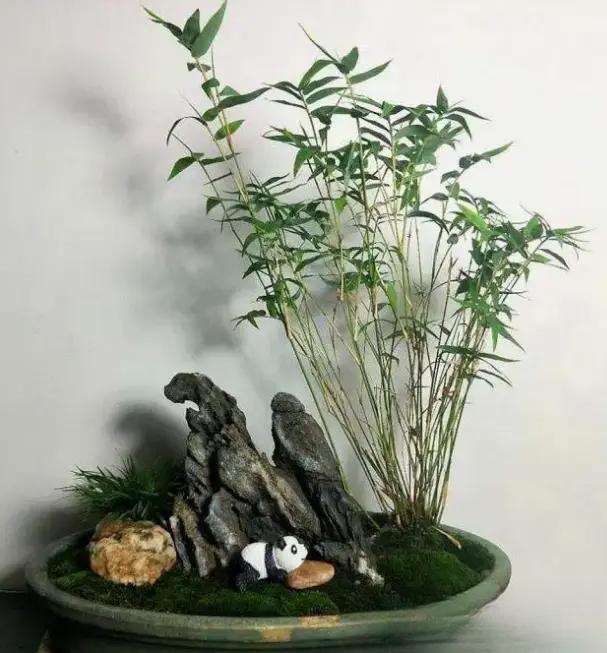
When cultivating green bamboo bonsai, we must also follow the natural laws of plant growth and combine artistic creation to show the unique charm of green bamboo. At the same time, we must also pay attention to environmental protection and ecological protection, rationally utilize resources, and promote harmonious coexistence between man and nature.
The second type: Nandina domestica
Nandina domestica, also known as Tianzhu or Red Tianzhu, is an evergreen or semi-evergreen shrub belonging to the genus Nandina of the Berberidaceae family. It is native to Japan and is widely distributed in East Asia. It is often cultivated as an ornamental plant due to its graceful posture and colorful seasonal changes, especially in Chinese gardens and bonsai art.
Plant characteristics:
Morphological characteristics: Nandina domestica is usually about 1-3 meters tall, with an upright stem and gray-brown or dark red bark.
Leaves: The leaves are compound and deeply pinnate. Each leaf has 5-9 leaflets. The leaflets are elliptical-lanceolate with fine serrations on the edges. The leaf color changes with the seasons, green in spring and summer, and turns red or purple in autumn and winter.
Flowers: Nandina domestica has small white or pale yellow flowers that usually bloom in summer in upright racemes.
Fruit: Red berries are formed in autumn, which are spherical or ellipsoidal. Each fruit contains a seed. They are bright red when ripe, which attracts birds and other animals to eat them and is conducive to the spread of seeds.
Bonsai characteristics:
Various shapes: Nandina domestica bonsai can be cultivated into a variety of shapes, such as big tree shape, cliff shape, slanting trunk shape, curved trunk shape, etc. through pruning, tying, hanging and other techniques.
Highly ornamental: Nandina domestica bonsai is evergreen all year round, especially in autumn and winter when its leaves and fruits turn red, making it extremely ornamental.
Easy to manage: Nandina domestica is highly adaptable, shade-tolerant, and resistant to a certain degree of drought. It is suitable for indoor and outdoor maintenance and is an ideal bonsai material.
Beautiful meaning: In culture, Nandina domestica is often given the beautiful meaning of auspiciousness and peace because of its tenacious vitality and fiery color.
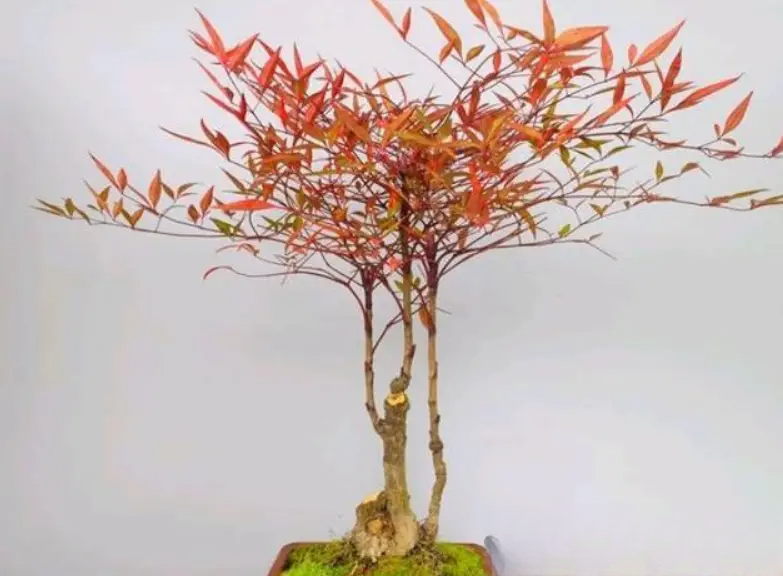
Nandina domestica bonsai is a fine product that combines traditional art with modern home decoration. Its unique cultural connotation and artistic value make it very popular in the bonsai market.
The third type of yew
The yew is an evergreen tree of the genus Taxus in the Taxaceae family and is also a unique and rare plant. It has high ornamental and ecological value and is known as the "panda of the plant world". The following introduces the plant effects and bonsai characteristics of the yew.
Plant Effects
Medicinal value : Taxus contains a unique natural anti-cancer ingredient - paclitaxel, which has a good therapeutic effect on many types of cancer.
Ecological value : Yew is an excellent ecological tree species that can adapt to a variety of environments and has significant effects on soil and water conservation, air purification, etc.
Ornamental value : The yew tree has a beautiful shape, is evergreen all year round, and has bright red fruits, making it very ornamental.
Environmental value : Yew can absorb a variety of harmful gases and play a positive role in improving environmental quality.
Bonsai characteristics
Various shapes : Taxus bonsai can be created into a variety of different shapes based on the shape of the tree stump, such as curved trunk, slanted trunk, cliff style, etc.
Resistant to pruning : The branches of yew are soft, easy to tie and prune, and convenient for shaping.
Slow growth : The yew grows slowly, is suitable for making small and medium-sized bonsai, and is relatively simple to manage.
Adaptability : Yew is highly adaptable, shade-tolerant, and suitable for indoor maintenance. It is a good indoor ornamental plant.
Evergreen : Yew remains green all year round and has a good decorative effect.
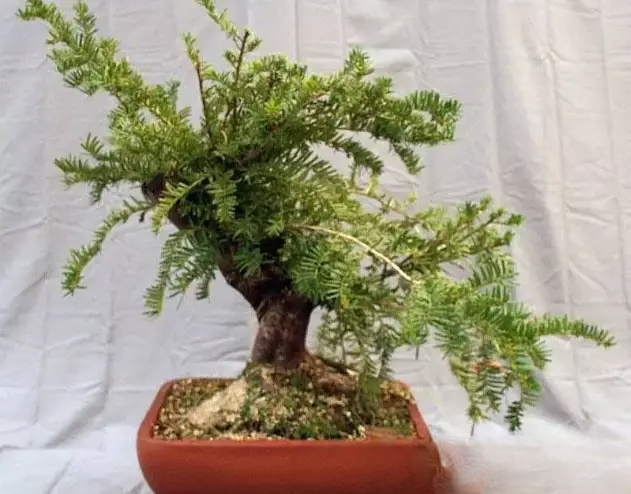
Since yew is a key protected plant, wild resources are strictly protected and illegal logging and trading are prohibited. The yew and its products sold on the market, such as bonsai and wood, should all come from legal artificial planting bases. When purchasing yew bonsai, you should pay attention to choosing a reputable merchant and confirm its legality.
The fourth type: Peach
The peach tree is an ornamental plant of the genus Peach in the Rosaceae family. It is a variant of peach. It is famous for its beautiful flowers and unique tree shape. It is often cultivated as an ornamental tree and is very popular in gardens. The plant characteristics and bonsai characteristics of the peach tree are as follows:
Plant characteristics
Growth habits : Peach likes an environment with plenty of sunlight and good ventilation. It is not very demanding on the soil, but well-drained sandy soil is preferred.
Flowering period and color : The flowering period of the peach tree is usually in spring. The colors are diverse, including pink, white, etc. The flowers are double-petaled and very beautiful.
Fruit characteristics : Although the main value of the peach tree lies in its ornamental value, its fruit is also edible, but the taste and size may be slightly inferior to ordinary peach varieties.
Adaptability : Peach blossoms have strong adaptability and can withstand a certain degree of cold and drought.
Bonsai characteristics
Shape design : Peach bonsai is usually shaped into various artistic forms through pruning and tying, such as slanting trunk style, cliff style, etc.
Pruning management : In order to maintain a beautiful tree shape and promote healthy growth, regular pruning is required to remove diseased and weak branches and keep the crown ventilated and light-permeable.
Soil and Fertilization : Bonsai soil requires good drainage and strong air permeability. Fertilization should be mainly decomposed organic fertilizer, and excessive nitrogen fertilizer should not be applied to avoid affecting flowering.
Watering management : Pay attention to watering for the peach bonsai, keep the soil moist but not waterlogged, so as not to cause root rot.
Pest and disease control : Pink peach is easily attacked by pests such as aphids and red spiders, so regular inspections and appropriate prevention and control measures are required.
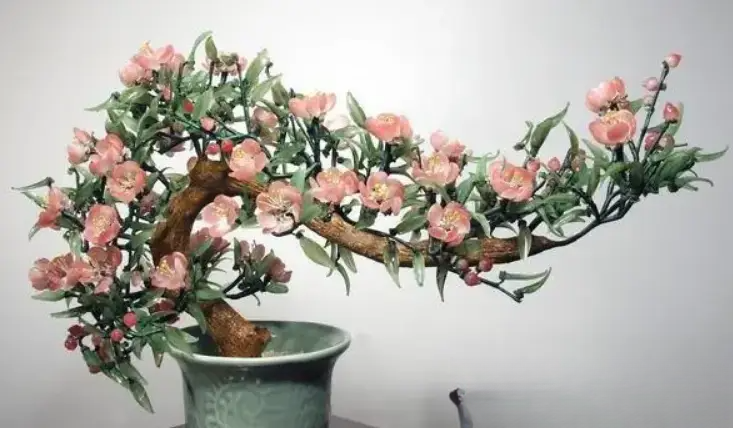
As one of the symbols of traditional culture, the peach tree has bright colors and beautiful tree shape, and is a good choice for garden landscaping and bonsai art. Through careful cultivation and management, a bonsai can show a harmonious and elegant charm, giving people a beautiful enjoyment.
The fifth camellia
Camellia, scientifically known as Camellia sinensis, is an evergreen shrub or small tree of the genus Camellia in the family Theaceae. Camellia is native to China and is one of the traditional ornamental flowers that are loved by people for its bright colors, various varieties, and rich flower shapes. Camellia is also widely used in bonsai art to show its unique plant characteristics and artistic charm.
Plant characteristics
Growth habits : Camellia likes warm and humid climate and is suitable for growing in a semi-shady environment. They are not strict about soil requirements, but well-drained, loose and fertile acidic soil is preferred.
Leaf characteristics : Camellia leaves are leathery, smooth, dark green, of various shapes, and usually with serrated edges.
Flower characteristics : Camellia has rich colors, including red, pink, white and other colors. The petals are bowl-shaped or peony-shaped, and the flower shapes are diverse, with single petals and double petals.
Flowering period : Camellia has a long flowering period, generally starting from late autumn to the following spring, and some varieties can even bloom until early summer.
Reproduction method : Camellia is usually propagated through grafting, cuttings, layering, etc., among which grafting is an effective method to maintain the characteristics of the variety.
Bonsai characteristics
Diverse shapes : Camellia bonsai can be shaped into tree shapes with distinct layers and various shapes, such as cliff style, straight trunk style, slanted trunk style, etc. through pruning, tying, hanging and other techniques.
Artistic value : Camellia bonsai combines natural beauty and artistic beauty. It is not only an ornamental plant, but also a work of art with high artistic value.
Rich meaning : In culture, camellia is often given the meaning of auspiciousness, beauty and nobility because of its tenacious vitality and beautiful appearance.
Maintenance requirements : As a bonsai, camellia needs appropriate light and water, and at the same time, attention should be paid to cold protection and prevention of diseases and pests.
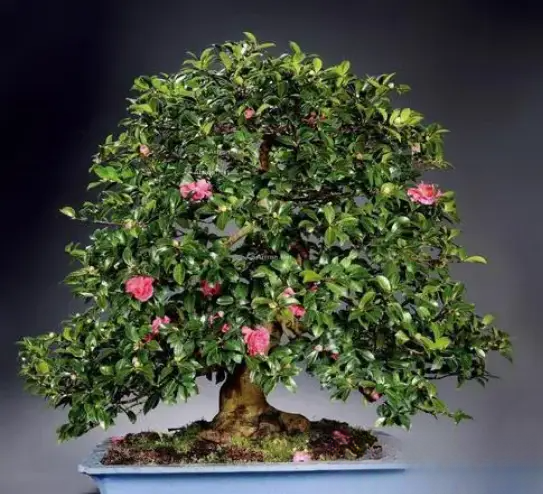
Camellia is not only loved as an ornamental plant, but its bonsai form also occupies an important position in traditional culture, reflecting people's pursuit of natural beauty and aesthetic taste. When caring for camellia bonsai, it is necessary to carefully care for it according to its plant characteristics to show its best artistic effect.